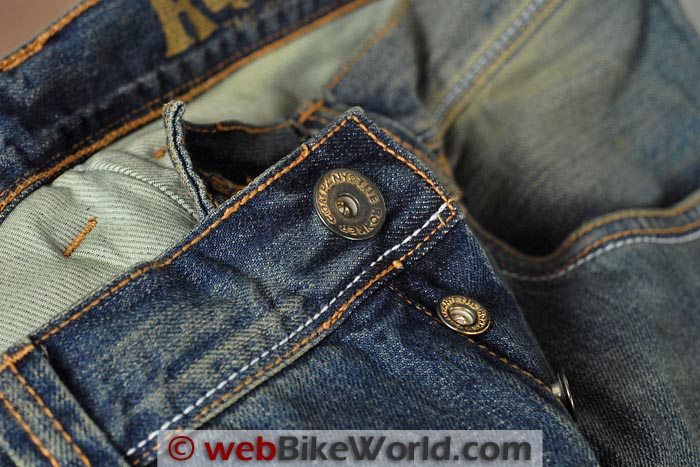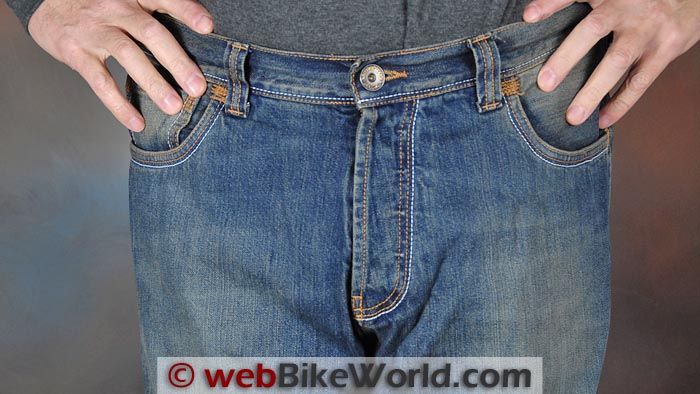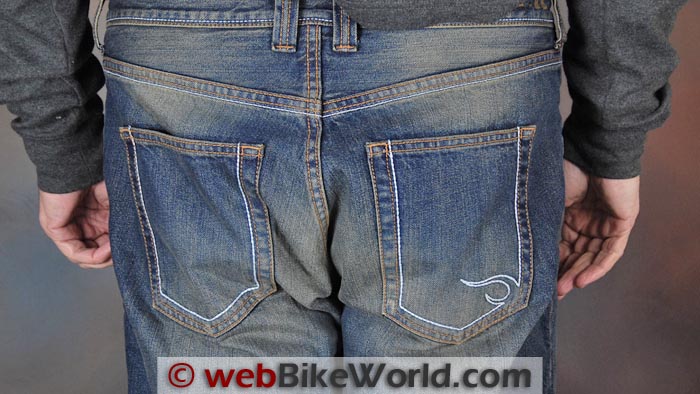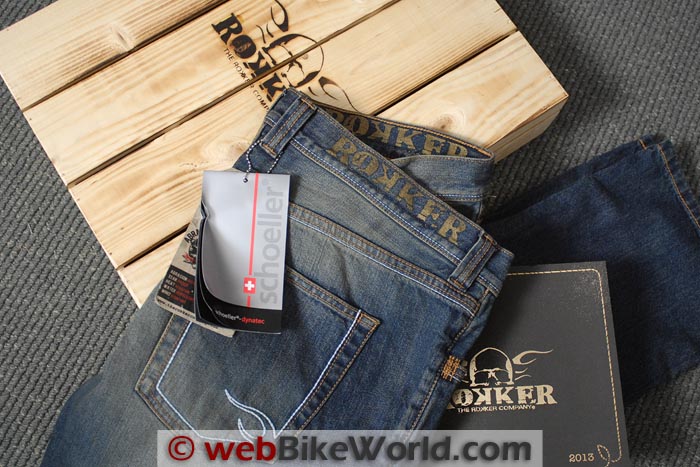The Rokker Original (actually, it’s Original Rokker) jeans are very comfortable and they’re also probably the best fitting motorcycle protective jeans I’ve tried to date.
You’d never know there’s a full-length Schoeller Dynatec (.pdf info sheet) lining underneath because the outer stitching is nearly identical to street jeans.
The Dynatec lining is soft and comfortable, unlike the Kevlar blends used in other jeans.
Optional d3O knee protectors are available (at extra cost) to fit inside pockets in the Dynatec lining.
It’s nearly impossible to tell that these are motorcycle jeans with a full protective lining, because the stitching has been carefully designed to mimic street jeans.
The Rokker jeans don’t have a CE rating, however, and the price is breathtaking.
We’ve seen a lot of advances this year in motorcycle jeans — to a point where jeans can now be considered as a serious alternative to other types of dedicated motorcycle pants.
One of the advantages of wearing a pair of good-looking jeans is that you’re dressed for the occasion when you arrive at your destination and that’s certainly the case with the Rokker Original jeans, which were designed to mimic a normal pair of street jeans.
The downside is that generally speaking, motorcycle jeans are missing the padding and/or protectors that can be found in a good pair of textile or leather motorcycle pants.
Also, denim fabric by its nature has a lot of “grip”, so it’s going to have more friction as you slide down the asphalt compared to a nylon, polyester, Cordura or even leather shell. The friction can theoretically cause imperfections in the road to catch the fabric, causing a tumble rather than a slide.
The Rokker Company is apparently new to the game, with current offerings of jeans for men and women and jackets, boots and other accessories for men.
Rokker is sort of a German version of the French VQuattro company, in that they both offer high quality protective clothing with tons o’ style. At a price.
Schoeller Dyantec: The Rokker Original Jeans Secret Sauce
One thing’s for sure: the Rokker Original jeans fit me like no other. In fact, they’re my new standard for jeans of any type. And this is despite the Schoeller Dynatec lining.
In fact, I think the Dynatec liner is partly responsible for the comfort of the Rokker Original jeans. It just feels better than raw denim and its smooth surface finish helps the jeans slide more easily over my legs when I’m walking or sitting.
Schoeller is coy about Dynatec ingredients, saying only that “Possible fabric components” include “high-tensile polyamide developed specially for Schoeller, other polyamides such as Cordura” and “elastic monofilaments”.
Apparently, Schoeller will work with the OEM to customize the Dynatec fabric to include various features, such as EN471 visibility colouration, water resistance, flame retardants and more.
What isn’t apparent is whether or not Schoeller has created a special Dynatec for Rokker, because neither Rokker nor Schoeller mentions this specifically, at least in any information I can find.
They do say that the Dynatec lining in the Rokker jeans is “made of 100% Schoeller Dynatec” which is “abrasion resistant and drop resistant, tear-resistant, temperature resistant”.
Rokker also states that their version of Dynatec has Cordura and Dynafil TS 70 reinforcements”. Research indicates that Dynafil TS 70 has a melting point of 290°C. The material complies with the “Oeko-Tex Standard 100“.
What is not listed is a CE certification or test results for the Rokker jeans, which is a bit disappointing, because as motorcyclist consumers, the CE testing and lab certifications are the only things we can go by other than hearsay.
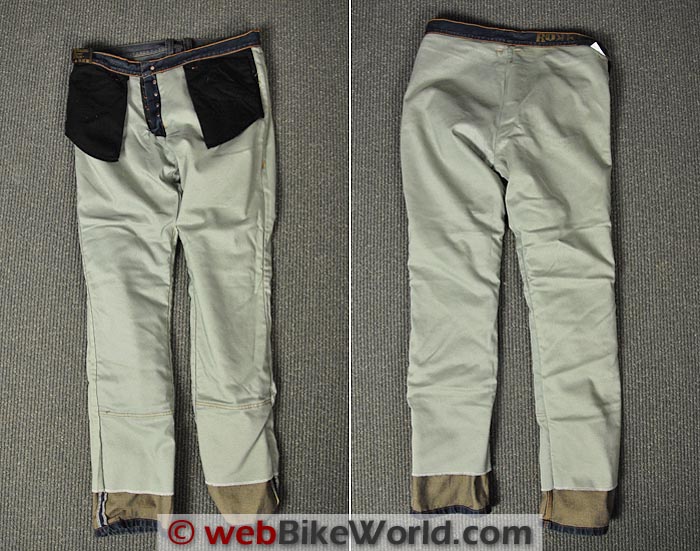
Fit and Sizing
Rokker currently has 7 different jeans in their men’s lineup and 4 different women’s jeans. Besides the Rokker Original jeans, they have the Rockstar, Revolution, Black Jack, Rebel, Original Rokker Raw and the Red Selvage.
The differences are in fit, leg width and variations in colors and wear/fade/stonewashing details, but the Rokker Original jeans were supposedly matched to the classic Levi’s 501 Original Fit jeans (thus the “Original” name?).
Sizes range from a 29″ to 36″ waist in single increments (i.e., 31 and 33 are available), all with a 34″ inseam. A 36″ inseam is also available in sizes ranging from a 34″ to 42″ waist but in even sizes only.
I have a 35″ waist and the size 36×34 Rokker Original jeans fit me very nicely and seem exact to size, with the 36″ waist just a touch big but fine for motorcycle riding (and for wearing my Bohn Cool Air Bodyguard (review) underneath).
Discussions with other Rokker owners indicate that the sizing runs true for other sizes as well.
The denim is high-quality stuff, said to be 11.5 oz. weight. The weave feels heavier and denser than my street Levi’s and Wrangler jeans.
The Dynatec liner is relatively thick compared to the Kevlar or other types of linings in any of themotorcycle jeans reviews we’ve published, but Rokker has apparently compensated for the thickness of the lining after the jeans have been stonewashed to make the sizing correct — a nice feature.
I have a 31″ inseam for street pants but the 34″ inseam in the Rokker jeans is perfect; it leaves enough coverage when I’m seated on the bike, yet the pants don’t look too baggy at the ankles when I’m standing.
So I’ll leave the cuffs as they are, but the Dynatec liner is designed so that it ends 100 mm from the leg cuff, which means you can either roll the cuffs up or have the length shortened to your preference.
 Construction and Protective Features
Construction and Protective Features
It looks like a lot of thought went into how the thick Dynatec liner is stitched into the Rokker Original jeans. The liner is attached all the way up at the waistband and there are very few other seams or stitch lines anywhere else.
The subtle feature here is that the Original jeans look nearly identical to a pair of street jeans — you don’t see any horizontal stitch lines or anything else that indicates that these are lined with anything at all.
This design also helps to make the Rokker jeans comfortable and since the Dynatec liner breathes, the jeans aren’t hot at all when worn indoors. That’s part of the magic — you could easily wear these jeans to work all day long and neither you nor anyone else would know the difference.
Rokker has also eliminated any of the rivets found on classic Levi’s street jeans, to prevent scratches on the fuel tank.
The pockets have a cool-looking quadruple bar tack stitch pattern, which looks vintage, rugged and has that worn look all at the same time, while probably offering better tear resistance than any brass rivet could possibly provide.
Protector Pockets?
The jeans do not have internal hip padding, nor is there any accommodation for it. Rokker sells a bespoke set of d3O knee protectors specifically designed for the jeans.
They’re reasonably priced at 30 bucks (although you’d think they’d throw in a set, considering the price of the jeans!). The knee protector pockets are hidden behind the liner; reach up under the liner to access the pockets.
For ultimate protection, however, I wear the Bohn Cool Air Bodyguard (review) full protective underwear, which fit under the Rokker Original jeans. I usually discard the protectors that come in motorcycle pants anyway and prefer the Bohn underpants for several reasons.
First, the Bohn pants have more surface area of coverage than any of the protectors included in most motorcycle pants. Second, because they keep the CE rated protectors nice and close and tight to my knees and hips, which is necessary for best protection.
Most motorcycle pants other than race leathers can not do this because the pants would be too tight to wear.
And finally, the Bohn underpants have a silky-smooth, stretch and very breathable shell to hold the protectors. This makes any outer pants slide much more easily, which makes it easier to move around on the bike.
It’s overall a better system in my opinion; the pant shell does the abrasion resistance and weather protection and the underwear protects against impacts. I wear my Bohn underwear all the time, summer an winter.
The only downside, of course, is that if you’re wearing the jeans to work, you’ll probably want to remove the underwear during the day.
Pockets and Fly
The Rokker Original jeans have the classic 5 pocket style, with two rear patch pockets, two slash front pockets and the traditional coin pocket.
All of the pockets are triple-stitched, with two rows of the classic copper-colored stitching and then another row of white stitching on the inside. I could probably do without the white stitching, especially on the rear pockets, where it also features a flame embellishment on the lower right-hand corner of the right pocket.
I guess these give the pants some extra style, but it kind of reminds me of 1980’s designer jeans, a styling trend that is best forgotten. Maybe it’s coming back? I hope not…
The front has a brass main button and the fly uses 4 smaller buttons. The button holes were correctly designed to be just tight enough to make it easy to insert the buttons without being so tight that you have to fuss a little too long down there. Buttons vs. a zipper is a matter of personal preference; I don’t mind the buttons.
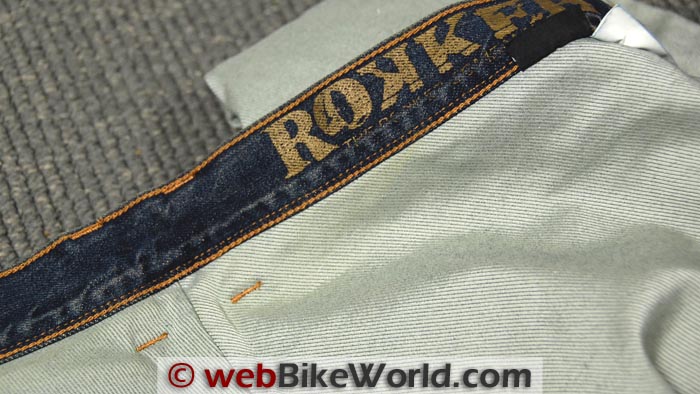
Riding With the Rokker Jeans
The Rokker Original jeans really do feel very comfortable for sitting, walking and motorcycling. Again, the Dynatec liner actually seems to help in this regard.
The liner is said to be water- and wind-resistant but I’m not sure about this. I can feel the air coming through when I ride; less so than with standard street jeans but about the same as any other lined motorcycle jeans I’ve worn.
Not so good for (current) winter weather perhaps, but a good omen for the summer that can’t get here any too soon.
As for water resistance, we’ve been having snow rather than rain, but some simple kitchen tests indicate that the denim sucks up water as fast as any street jeans.
The Dynatec liner does seem to resist the water leaking through, however, which is rather amazing, since air can get through. So there is some of the “membrane” effect at play here.
Conclusion
The Rokker Original jeans are comfortable, good-looking and the full-length, front/rear Dynatec liner is sewn in with a minimum of stitches to make it an integral abrasion protection device.
The jeans look good and they fit perfectly and they don’t at all look like motorcycle jeans, which is a big plus.
Unfortunately, no CE testing has been conducted apparently, because there’s nothing on the hang tags or the Rokker jeans website that indicates the jeans are CE approved.
So we’ll have to use a bit of faith to assume that the Schoeller Dynatec liner and the overall construction of the jeans and the special method used to install the liner is better than other brands, although the Resurgence Gear jeans (review), for example, have been tested and certified to the EN 13595-2 standard.
Do I like ’em? You bet. I feel better wearing the Rokker jeans than any others and the combination of fit, comfort and the full, thick Dynatec liner provides a level of confidence beyond other motorcycle jeans and even beyond some cheaper textile pants I own.
But now we come to what, in the end, will probably be the biggest issue that motorcyclists will have with the Rokker jeans: the price. The Rokker Original jeans have a list price of $469.00.
That’s exceptionally expensive in anyone’s book. I’ll leave the judgments to our readers, but it will be interesting to hear from Rokker jeans owners to learn more about their criteria and purchasing decision.
More wBW Motorcycle Jeans Reviews
More wBW Motorcycle Jeans Reviews | Motorcycle Clothing Reviews
Owner Comments and Feedback
See details on submitting comments.
From “C.J.” (September 2014): “While I have the Revolution Jean from Rokker, not the Classic as in Rick’s review, there are some things I wanted to point out as he did lump the rest of the Rokker line as being similar.
The Revolution, at least, is not the same. Oh, the fit, finish, and comfort the reviewer stated is certainly the same, but everything else is different. The Revolution isn’t really a denim surface, it is a modified Schoeller fabric and is more of a synthetic than cotton. Underneath this is the c-change fabric that is 100% water and wind proof as well as allowing the material to breathe.
I was told that the overall venting of the c-change is greater for a given area than Gore-Tex, and I can believe it. The Revolution has pockets for both hip and knee C3O armor (that is included). The lining is completely taped at all the seams (like a high quality tent) so it really is waterproof and in the showers I’ve been in, they did not leak at all.
The outer pant did get wet to the touch, but dried fairly quick. Absolutely not typical soggy denim. Compared to typical textile pants and even the old Draggin’ Jeans, these feel more like a quality blue jean than a technical pant.
I also love the fact that there are no odd seams that indicate anything other than a pair of jeans. Got chastised by one friend for not being ATGATT — you really can’t tell. That was until I turned up the cuff to show the lining and twisted the knee area to show the armor (Yeah, the armor is not real obvious, even when wearing them off the bike).
You are not supposed to hem these as the liner goes right to the cuff and any cut or sew of the bottom will ruin the waterproof nature at that point. It is OK to machine wash and they even recommend an iron at 140 degrees to help preserve the water repellant nature of the outer fabric. This allows water to bead off — regardless, the inner layer does not allow ANY water past. I have not had the unfortunate pleasure of testing the protection on these.
However, I did have a slide in a BMW pant that uses a similar Schoeller Dynatec fabric (although I guess companies can get some variance in their weave) and the BMW pants held up amazingly despite being fairly thin for protective pants.
The price of the Rokker Jeans is quite steep, but after my first long day in the saddle in mixed weather, I could not be happier. That I don’t need to deal with vents, rain layers, etc. is nice. Heck, I have not even felt a need to add a thermal layer even in temps in the mid 40’s F, which is surprising as these are also comfortable in the low 80’s F.
I almost always switch to a high quality mesh design when the temps get hot, but this one day, the forecast was wrong and it got much warmer than expected. I was shocked that I was as comfortable as I was. The same temps with Draggin’ Jeans would have left me a miserable sweaty mess. The breathable layer just seems to work.
Unlike many textile pants, I have no need to quickly remove these when off the bike. I can easily run errands, attend a dinner or movie and not feel like I’m encased in plastic.
If I had one complaint, it is that I prefer a more ‘relaxed’ fitting jean, but there is something to be said for a tighter pant to keep the armor in place. The ONLY two reasons I can think of why these are not the ideal riding pant are 1) You have a need for race quality leathers or 2) the price is simply too much.”
From “P.C.” (January 2014): “I agree with your whole summary of the jeans, right down to the white stitching in the rear pockets, that’s the one thing that I could do without as well.
As far as the price goes I was a bit hesitant, and then I thought about it, what if I was riding down the road one day and my bike was to slide out from under me, If I could press a button freezing myself in midair, would I take $500.00 (That’s what it cost with the addition knee pads which I also agree that they should throw in for the price) out of my pocket and buy the jeans and have them on at that moment?
Would I? The answer would be yes without hesitation! So I purchased them. I am very happy with with the fit and feel of the jeans, the only situation I have is with the pockets for the knee protection, the pads they don’t seem to stay at the proper height to protect my knees. The pockets are a little too deep in my opinion.”


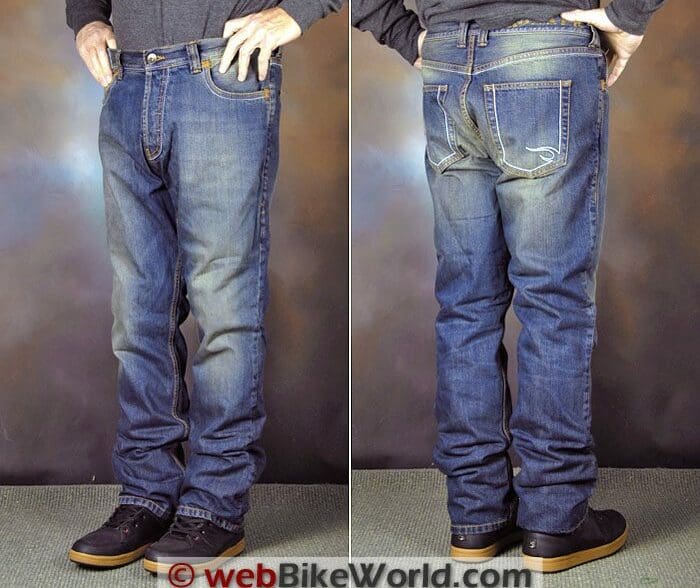
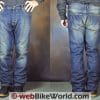
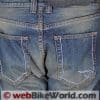
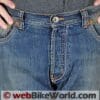
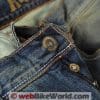
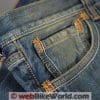
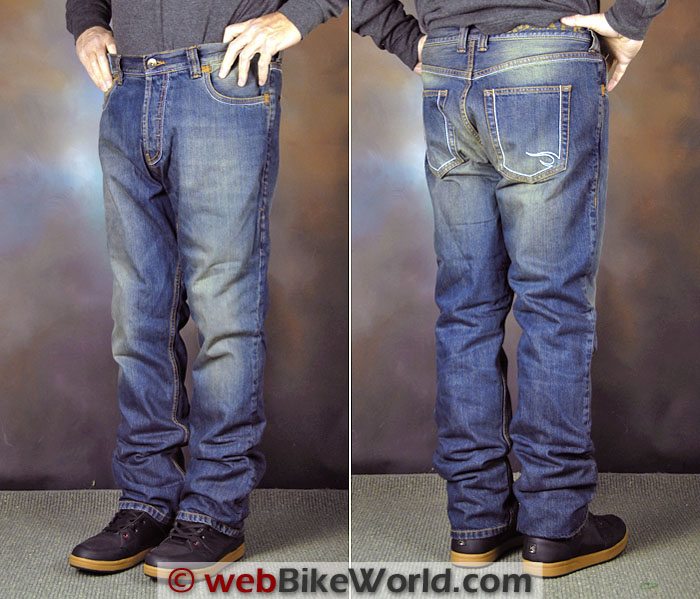
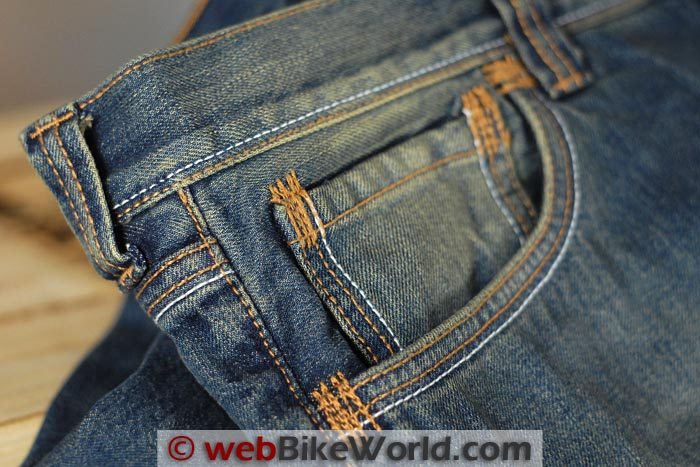 Construction and Protective Features
Construction and Protective Features